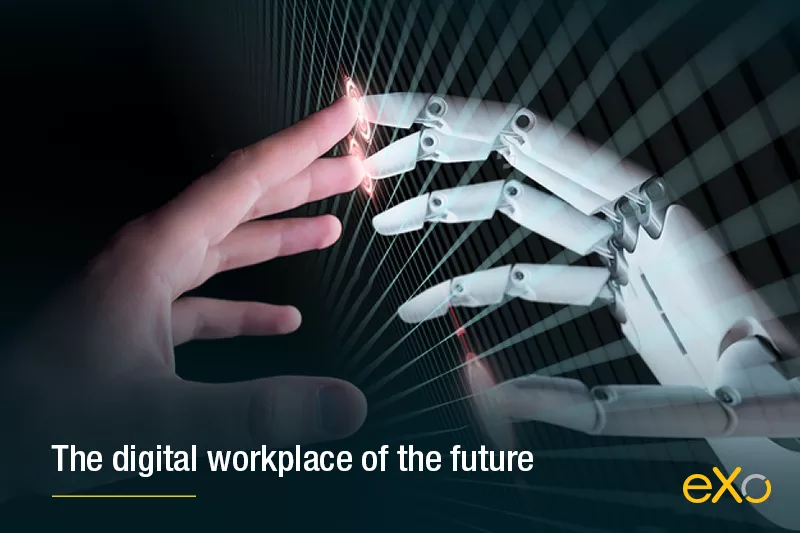- Brahim Jaouane
- July 3, 2019
What is a digital workplace and where did the term originate?

Content
1. The evolution of the way we work
In contrast, as soon as Marry arrives at work she connects to her digital workplace. There, she can check the latest company news, search for different types of content and connect with her peers and clients. Instead of receiving a brief via fax, the client can send it directly on the digital workplace (if they have an account) or use third-party applications like Skype or other messaging apps for real-time communication. With the digital workplace and third-party applications, Marry can locate and share information with ease and make the most of her day.
The contrast between John and Marry shows how far enterprise software has come. Digital workplace solutions and other specific business applications have gained momentum in recent years. According to The 2017 State of the Digital Workplace Report, 95 per cent of organisations agree that a digital workplace is important and 44 per cent say they already have a solution in place. The popularity of these solutions is reflected by the steady growth of the digital workplace market, which is expected to rise from $13.4 billion in 2018 to $35.7 billion in 2023, according to a report by MarketsandMarkets.
But what should we expect from the digital workplace and how will it affect our lives?
2. The digital workplace of the future
A lot of experts and researchers have tried to figure out what the digital workplace of the future might look like. There is no right answer. The possibilities are endless and the emergence of new technologies will make it difficult to give an accurate prediction. In a report titled Digital Workplace 2030, Paul Miller and co tried to explore the future of digital workplace technology. The report examined a number of factors, from the change in demographics to globalisation, climate change and innovation. It stated that four dimensions are expected to change: space, capability, intelligence and beauty. According to this report and many other publications, experts expect a change in the way we perform our jobs as the physical and virtual office become better integrated. Solutions that provide flexibility and remote working for employees, like virtual offices and ChatOps, have been on the rise in recent years. This trend is not expected to slow down any time soon, with big corporations like Cisco, Microsoft and others investing heavily in this kind of technology.
The second dimension is capability. As mentioned in the comparison between the two marketing specialists, enterprise software is moving from connecting pieces of work to actually allowing users to perform their jobs within a holistic suite. A digital workplace in the near future may include some of the technologies we have today, like virtual reality (VR), wearables, IoT and chatbots. The wave of new technologies and enhancements to existing ones can facilitate work and reshape some of the jobs we have today.
Another dimension that is expected to shape the digital workplace of the future is artificial intelligence (AI). Tech giants like Google and Microsoft are allocating a lot of resources to research and development. Although we are still far away from a fully intelligent workplace solution, the early signs are promising. It is expected that by 2030, AI technology will be fully integrated within organisations to provide data-driven decision-making, assist with daily activities and redefine some job roles.
The fourth and final dimension mentioned in the report is beauty. By beauty, the authors are referring to the relationships and interactions users will have with the digital workplace. Furthermore, with each passing year, a lot of improvements are being made to the well-being of employees. A comparison between working conditions in the 1950s and today may give you a picture of how the working experience is improving. Digital workplace design is expected to change depending on the job role. Technologies like augmented reality (AR) and VR will take centre stage as employees spend less time looking at their device screens and more time interacting with objects. Progress is being made in this field especially in retail, with Amazon stores, and it will only be a matter of time before these technologies are introduced to enterprises.
Digital workplace solutions have come a long way over the years to respond to the growing needs of organisations. Continuous innovation by tech giants in new technologies like AI, AR, IoT, wearables and more will allow organisations to get the most out of their teams and change the way we work for the better.
tools and information
FAQ
You will find here Frequently Asked Questions about digital workplace with all the answers in one place.
What is a digital workplace?
A digital workplace is a next generation of intranet solutions or intranet 2.0 that is based on three pillars: communication, collaboration and information. In a way this definition is true but it doesn’t cover the whole spectrum of the term.
Here are some definitions of digital workplace:
- An evolution of the intranet
- A user centric digital experience
How to launch an effective Digital Workplace?
- Understand users’ needs
- Identify your digital workplace ambassadors
- Build the digital workplace brand
- Training and onboarding
- Plan the big day
What does digital workplace really mean?
The digital workplace is the virtual, digital equivalent of the physical workplace. It is a holistic user-centered solution used to connect, engage, and empower employees. Through an employee-centered hub, it encompasses a set of tools, applications, and platforms for a complete work experience.
How to be a good digital workplace manager?
- Analytical skills and approach
- Focus on employees
- Communication and strategic vision
➝ The success of a digital workplace project depends on a number of factors



